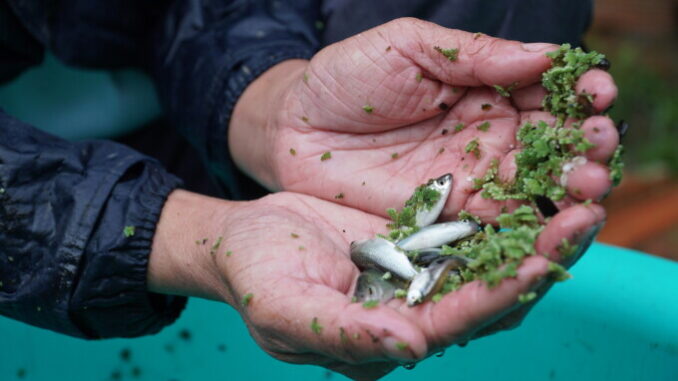
DONG THAP – Master Nguyen Huu Tan, for nearly 30 years specializing inbreeding, “midgets” many aquatic species, especially Linh fish, which are gradually scarce in the Mekong Delta.
Mr. Tan’s house is located on Highway 80, passing through the Chau Thanh district. In front of the house, there are many fish nurseries, under the bamboo grove is a system of tanks and ponds with an area of 7,000 m2. In the morning of mid-November, the 58-year-old owner, hard at work under the microscope, is micro-surgery a male shrimp into a fake female, helping to produce all males when breeding. This supports farmers, with high efficiency because male shrimp grow faster than female shrimp.
In 1986, he graduated from Can Tho University, majoring in fisheries, worked at the Department of Fisheries in his hometown and was assigned to build breeding centers. No matter where or how he works, the fisheries engineer always cherishes and researches the typical copper fish species in the Mekong River region, both preserving and having a source of quality seed for farmers to grow commercially, make and grow. rich.

In 1992, he successfully “midwifed” for goby fish – a delicious fish dish of the delta people but quite scarce, especially the big fish. Unlike shrimp, goby does not breed by sex because both males and females grow equally. The broodstock fish to spawning period are kept together in captivity, injected with reproductive stimulants after a few hours of spawning and insemination.
Breeders need to know the reproductive characteristics of each type of fish to create suitable conditions and high efficiency. After the fish is born, the eggs are taken out and put in a separate tank, about 18 to 24 hours to hatch, and take another month to raise with water eggs (bo bo). They grow into fry (fish about a month old), fingerlings can be sold.
When he offered the first batch of fingerlings, he received positive feedback from farmers and even exported to Taiwan at extremely high prices. At that time, a duck egg sold for 15 dongs, but a fry cost up to 250 dongs, 16 times more. The successful breeding of goby is profitable for farmers and helps to reduce wild fishing leading to depletion.
Life associated with the profession of “midwife” for fish, Mr. Tan felt sad when aquatic resources in the West were increasingly scarce. For example, Linh fish in the past were plentiful and cheap, but now “more expensive than fresh shrimp”. The reason is, in the flood season, the Linh fish follows the Mekong river downstream to lay eggs, which are completely exploited by humans. In addition, climate change and hydroelectric dams block the flow, causing a serious decline in aquatic resources in the West.
Three years ago, he successfully produced reishi fish and sold it to pond owners before the flood came. The Linh fish belongs to the species that lay eggs semi-floating (semi-floating, semi-submersible), so the breeding is usually in the evening, with continuous oxygenation when the mother and father fish pair up. When looking for a mate and mating, they make vocalizations.

“For many years in the profession, only Linh fish and Vinh catfish make such calls”, he played a video when they were mated to prove. The sound of fish croaking mixed with the murmuring water, the sound of them jumping on the water. After a few hours, when the fish was born, he drained all the water in the tank, used a cloth to catch the fertilized eggs, and put it in another tank to hatch the fry. The parents were released into the pond with some food to restore their strength.
Every year, Mr. Tan provides hundreds of millions of fry to farmers in the province to breed and supply young reishi to the market. He has a special affection for Linh fish not only because this aquatic species is the memory of many people but because they bring a lot of economic value, farmers can exploit.
“Our people should raise them instead of catching them. Only then will their descendants know the typical fish species of the region, but this momentum may be that the next generation only knows the Linh fish and choke fish through books. “, he said.
In recent years, the master from Dong Thap has turned to teach and is currently the deputy head of the aquaculture department at Dong Thap University. He taught students not only through books but also set up a fish breeding area, including 50 tanks for raising Linh fish, perch, catfish, snails, water hyacinth, etc. for them to observe and study.
Thanks to Mr. Tan’s guidance, Mr. Bui Tri Nhan, 27 years old (in Hong Ngu city) has successfully raised the reishi crop, after a month harvested 1.5 tons on an area of 10 hectares of rice, selling on average 130,000 VND per kg. , income 170 million dongs. “Uncle Tan is a passionate and dedicated person. Anyone who wants to raise fish but is not experienced enough will be guided by him,” Mr. Nhan shared. Follow vnexpress
